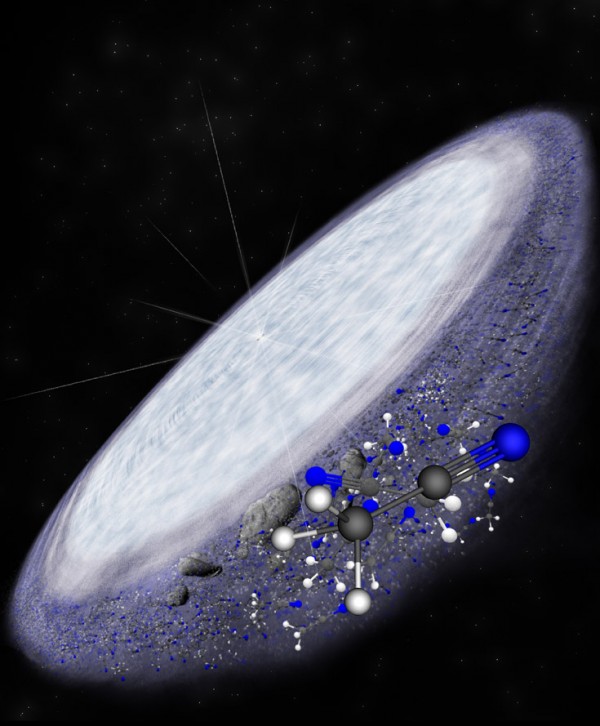Signs of Life? Organic Molecules Found in Young Star Just 450 Light Years Away
| Ana Verayo | | Apr 09, 2015 04:24 AM EDT |
(Photo : B. Saxton (NRAO/AUI/NSF)) Artist impression of the protoplanetary disk surrounding the young star MWC 480. ALMA detected the complex organic molecule methyl cyanide in the outer reaches of the disk in the region where comets are believed to form.
Astronomers confirm that organic molecules have been detected for the first time on a distant star. The presence of these molecules indicates alien forms of life could exist as these molecules are the basic ingredients of all life.
These complex organic molecules were detected in the dust surrounding an interstellar gas disk shrouding an infant star called MWC 480. These have been identified in an intense star forming region some 450 light years away from our planet.
Like Us on Facebook
Lead author Karin Öberg from the Harvard-Smithsonian Center for Astrophysics said this discovery strongly suggests our solar system isn't the only star system with the potential to create life and support life. She adds the intensely rich organic chemistry identified in this young solar system found evidence of cometary compositions that could be quite common.
This prebiotic chemistry found on Earth and inside our solar system is apparently occurring somewhere else in other galaxies, she confirms.
This one million year old galaxy was detected by the Atacama Large Millimeter/submillimeter Array (ALMA) radio telescope located in Chile. Scientists have identified that MWC 480 is surrounded by methyl cyanide, which is a complex molecule derived from carbon.
The young star's newly formed disk apparently holds these molecules in its farthest reaches. Astronomers liken this disk to our solar system's Kuiper's Belt where icy comets originate such as Comet 67P Churyumov/Gerasimenko now being orbited by the Rosetta probe.
Kuiper Belt comets still possess the exact, unchanged chemistry of materials found in our solar system during its infant stages when the planets were forming.
Öberg says the solar nebula our sun and planets were spawned from was already rich in water and complex organic compounds. With the discovery of MWC 480, this exact same chemistry exists elsewhere in the galaxy and beyond the universe in regions of stellar systems similar to our own.
Researchers also reveal the dust and gas surrounding the disk of the young galaxy will spiral down as it continues to grow and some of these complex organic molecules will be ejected into interstellar space. These remnants of the young galaxy will then ultimately transform into planets and comets or asteroids into a solar system like ours.
When these new alien worlds form, they'll carry these organic chemicals such as water in the habitable zone of the new star system.
Geoffrey Blake, a planetary scientist from the California Institute of Technology in Pasadena not involved in this study, said this will mimic the processes that took place in our solar system some billions of years ago. This study was published in the journal, Nature.
TagsSigns of Life? Organic Molecules Found in Young Star Just 450 Light Years Away, signs of life beyond solar system, signs of life in other galaxies, organic molecules young star galaxy, ALMA
©2015 Chinatopix All rights reserved. Do not reproduce without permission
EDITOR'S PICKS
-

Did the Trump administration just announce plans for a trade war with ‘hostile’ China and Russia?
-

US Senate passes Taiwan travel bill slammed by China
-

As Yan Sihong’s family grieves, here are other Chinese students who went missing abroad. Some have never been found
-

Beijing blasts Western critics who ‘smear China’ with the term sharp power
-

China Envoy Seeks to Defuse Tensions With U.S. as a Trade War Brews
-

Singapore's Deputy PM Provides Bitcoin Vote of Confidence Amid China's Blanket Bans
-

China warns investors over risks in overseas virtual currency trading
-

Chinese government most trustworthy: survey
-

Kashima Antlers On Course For Back-To-Back Titles
MOST POPULAR
LATEST NEWS
Zhou Yongkang: China's Former Security Chief Sentenced to Life in Prison

China's former Chief of the Ministry of Public Security, Zhou Yongkang, has been given a life sentence after he was found guilty of abusing his office, bribery and deliberately ... Full Article
TRENDING STORY

China Pork Prices Expected to Stabilize As The Supplies Recover

Elephone P9000 Smartphone is now on Sale on Amazon India

There's a Big Chance Cliffhangers Won't Still Be Resolved When Grey's Anatomy Season 13 Returns

Supreme Court Ruled on Samsung vs Apple Dispute for Patent Infringement

Microsoft Surface Pro 5 Rumors and Release Date: What is the Latest?










